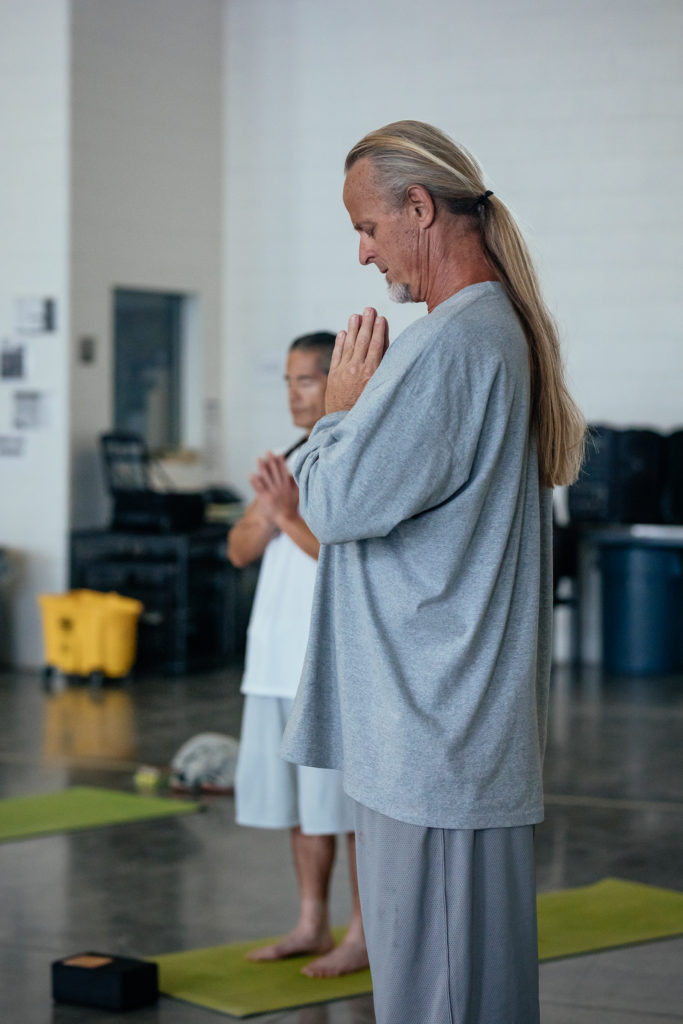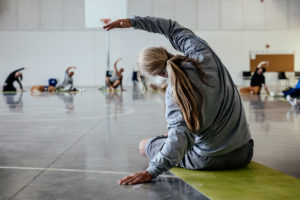“I’ve got my baby boy back.”
These are the words Mark Phelp’s mother shared when we asked her what changes she’d seen in her son since he’d started to practice yoga. Curiously – though maybe not when you begin to understand the close bond they share – that’s just what he said she’d say.
Last month ago, we introduced you to Mark, one of the participants in our program at Richard J Donovan State Prison in San Diego, CA. You can read the first part of the series here, and a follow-up piece here. We spoke to Mark’s mother, Carolyn and, sister, Margot as part of a not-yet-released short documentary about Prison Yoga Project.

“I think it’s kind of reset him, in a big way, and it’s really a beautiful thing to see. He’s a very tender loving man. I feel like this brought that back out in him, the tenderness,” reflects sister, Margot, of Mark’s yoga practice. Then she adds her thoughts on another side effect of the program. “I love the ripple effect the yoga program has on families. It’s much more pleasant to get a phone call from Mark now knowing that he’s going to be chill and he’s going to be enjoyable to talk to,” she added.
“A lot of people just assume people in prison are bad. And I used to think that too,” continues Margot. “Until Mark went to prison. And now, I know Mark, so I know that’s not true. All these men have something from their past that’s painful, and it has caused them to do whatever they’ve done. But they’re not beyond repair. They’re not beyond being loved.”
Mark is fortunate to have a family that loves and supports him. A family who can send him money. A family who believes in his ability to change. Many of the incarcerated people we serve don’t have that, and their weekly yoga practice might be the only visit they receive from a caring person on the outside who believes in them and supports them unconditionally. Even for those who do have family contact, the feeling may be bittersweet — the pain of separation runs both ways. Families and friends on the outside feel it too.
“He has a lot of family out here. He’s got children. He’s got grandchildren. I think he’s doing everything he can to better himself so that when he gets out he will be a better person for those of us who’ve been waiting for years to see him.” Margot begins to cry. She continues through her tears, “It’s been a long time, and I’m going to be the one to pick him up when he gets out.”

Mark’s mom, Carolyn, is vibrant and laughs often. We asked how often she gets to talk to Mark. “He calls me two or three times a week, sometimes two or three times a day, just to chat. He says, ‘Oh, I just like to hear my mama’s voice.’ And he tells us about his classes….yoga, especially.”
Still, coming to grips with the life her son leads and what led him to it is painful. “I hate to see him where he is,” his mom says, “but he’s there because of the things that he did. And he realizes that. And I realize that too.”
Carolyn tied her thoughts and her son’s thoughts about the transformative possibilities of yoga together in a profound way. “He thinks the yoga program should be mandatory for every violent offender in prison. If he thinks that much about the program, then you know it’s helped him tremendously.”
Finally, she states the overarching goal of the Prison Yoga Project as well as I could. “The improvements that I’ve seen in him and his attitudes and ideals in the last year-and-a-half to two years, I know he’s ready to get out. Ready to become a part of society and be able to help other people.”
Indeed Mark’s desire to be able to help others may very well tie back to his bond with his mother. As we noted in an earlier post, Mark has a strong desire to do something for “…these old guys we have in here.” I wonder if the origin of that desire lays in his separation from his mom. “I could sure use him out at my age of 82. I would sure love to have him around to help me out.”
When we share yoga with people on the inside, the benefits ripple out to their families, friends, and their communities.